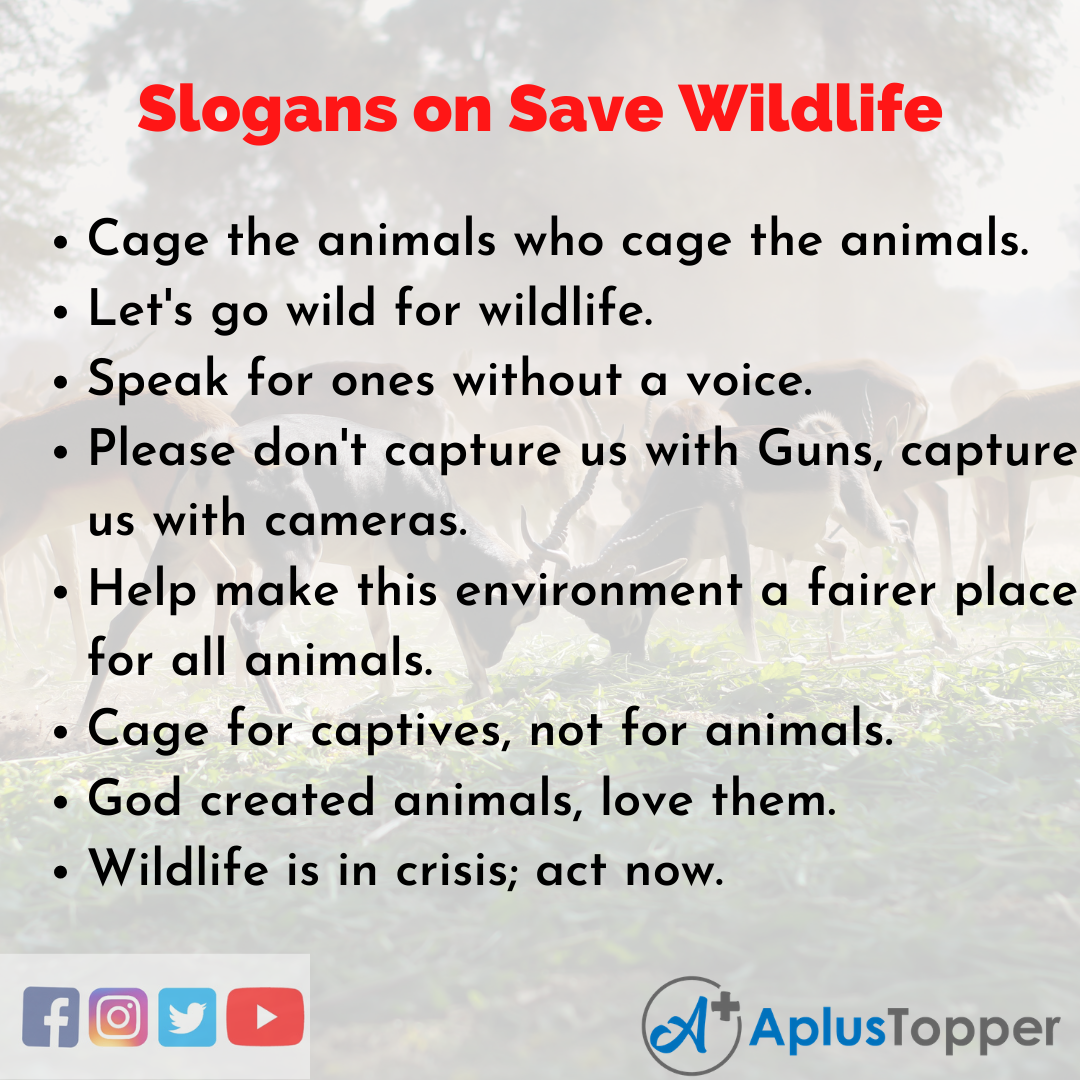Slogans on Save Wildlife: The term ‘wildlife’ not only refers to wild animals but also takes into account all undomesticated life forms, including birds, insects, plants, fungi, and even microscopic organisms. For sustaining an excellent ecological balance on this earth, animals, plants, and marine species are as valuable as humans.
Every organism on this earth has a unique spot in the food chain that helps contribute to the ecosystem in its unique way. But, grievously, today, several of the animals and birds are getting endangered. The natural habitats of animals and plants are being damaged for land development and farming by humans.
Students can read more Slogans about articles, events, people, sports, technology many more.
Slogans on Save Wildlife in English
Poaching and hunting animals for fur, jewelry, and meat are other vital factors contributing to wildlife extinction. If no stringent steps are taken to save wildlife, it would not be extended when they will find a place only on the list of extinct species. The extinction of wildlife species will undoubtedly have a deadly impact on the human race too. So, it becomes a great responsibility to save wildlife, our planet, and, most importantly, ourselves for us as humans.
15 Unique and Catchy Save Wildlife Slogans
1. Cage the animals who cage the animals.
2. Let’s go wild for wildlife.
3. Speak for ones without a voice.
4. Please don’t capture us with Guns, capture us with cameras.
5. Help make this environment a fairer place for all animals.
6. Cage for captives, not for animals.
7. God created animals, love them.
8. Wildlife is in crisis; act now.
9. Say no to animal abuse.
10. Time to stand up for wildlife.
11. Some species are dying away; can’t we help them in some way?
12. Wildlife conservation is the conversation!
13. Feed animals, don’t eat animals.
14. Wildlife is a must, and Please trust.
15. Wildlife: Save it for the world to cherish or leave it to perish.
Frequently Asked Questions on Save Wildlife Slogans
Question 1.
Why is it vital that we conserve wildlife?
Answer:
There are many reasons for conserving wildlife. It is necessary to maintain genetic diversity; plants and animals act as environmental indicators; they provide the natural materials for food and medicine; wildlife is pleasing to all, and it provides amenity. Also, a vast number of wildlife species are becoming extinct; therefore, we need to save them from maintaining ecological balance and biodiversity.
Question 2.
What do we understand by the term biodiversity?
Answer:
Biodiversity refers to all living things; micro-organisms, fungi, plants and animals, and the environments in which they exist, support, and are sustained by. Globally there are between 5 and 30 million different species, mostly insects, and there is an equally diverse array of habitats, from the tops of oceans to the bottom of oceans. But this diversity is gravely under threat due to humans’ dominance over nature and new advances in destructive technology and engineering.
Question 3.
How will we benefit by saving wildlife?
Answer:
All living organisms are interrelated, and all depend on wild species in one way or another. All green plants and all animals rely on micro-organisms cycling the chemical elements necessary for life. At the same time, many plants also depend on insects and other animals for fertilization and dispersal. Together all organisms resemble a living body with each part dependent upon others. We do not know what the negative impact of losing any of these species would be. Hence conservation is necessary.
Question 4.
Which wildlife species is the most crucial to saving?
Answer:
There is no one thing to conserve, and there are many! Different environmental organizations will have their own opinions on conserve, such as rare or endangered birds, flowers, or habitats. For example, habitats are ecosystems, woodland is a habitat that supports birds and flowers, so if there is no woodland, the other two cannot exist. So this may be the most important one to conserve. Still, if no birds are present, seeds cannot be dispersed, and flowers pollinated. Most conflicts of interest can be resolved by identifying the priorities of an area or species.
Question 5.
What is the goal and aim of saving wildlife?
Answer:
Wildlife conservation aims to maintain a wide variety of appropriate habitats and species and ensure that natural habitats continue to survive. Over hundreds of years, some wildlife species have adapted to the countryside, which people have affected. For instance, some birds benefit from woods that are regularly coppiced. In these instances, conservation trusts, voluntary groups, and local authorities traditionally manage habitats to recreate these conditions. habitats can also change, perhaps by becoming overgrown, sometimes preventing the survival of the species we are trying to protect.


